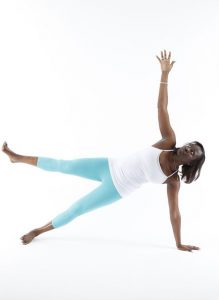Ease into Power Yoga
By Sandy Baird, DC

Power yoga is an athletic, fast-paced, challenging class that is usually performed in a warm room. The poses are linked together in a flowing manner, and the practitioner connects his or her breath to the movements in and out of poses, as a way to build-up internal heat. It was developed in the 1990’s and has gained recent popularity in the Bay Area. The two American teachers that are credited with the invention of power yoga are Beryl Bender Birch and Baron Baptiste. They developed their styles almost simultaneously, which isn’t surprising considering that they both studied under Ashtanga yoga master Sri K. Pattabhi Jois.
Power yoga is a good complement to a serious running training plan. Beryl Bender Birch, the wellness director of the New York Road Runners since 1981, introduced this type of yoga to the traditional athletic community. It is touted as a great therapy to rehabilitate an injury. There are eight axioms of power yoga, which bear remarkable similarity to the theories behind the cumulative injury cycle and general principles of athletic performance.
Axiom 1: You have to be hot to stretch.
This goes hand in hand with the recent research articles that provide evidence that static stretching before a workout may actually decrease the power output of muscles and leave them more vulnerable to injury. Save the static stretching for after a run, while you are still warming down.
Axiom 2: Strength, not gravity determines flexibility.
Without the strength work, the heat is not there, and thus the stretch work is not effective.
Axiom 3: Sports do not get us in shape. In fact, sports get us out of shape.
Athletes develop tight muscles and sports create imbalances because of repetitive training and uneven use of muscle groups, or the uneven use of one side of the body. Overuse of a certain muscle group creates an inflammatory process in which adhesions are laid down. These sticky adhesions (scar tissue) limit range of motion and cause pain and spasm. This causes decreased circulation and further tightness, which leads to further tissue trauma, and the whole cycle continues. Sports chiropractors use Active Release Techniques (ART) and Graston Technique to breakdown the adhesions from the bound-up soft tissues, so that the imbalances may be lessened, and range of motion may be restored. This results in more functional movement and less pain.
Axiom 4: All injury in sports is caused by a structural and muscular imbalance.
Except for accidents like falling off a mountain bike or getting kicked in a soccer game, structural imbalance is the #2 risk factor for determining risk of injury. Guess what #1 is? It’s previous history of injury!
Axiom 5: Muscular imbalances and structural irregularities don’t fix themselves.
We see this all the time in the clinic. You can stop running for two weeks and your knee pain may lessen, but unless you correct the underlying problem with muscle work, joint re-alignment, and rehabilitation exercises, the issue will come roaring back next time you run.
Axiom 6: Even iron will bend if you heat it up.
As connective tissue heats up, it becomes less “solid” and more “liquid”. In both bodywork and power yoga, it becomes more pliable for shaping when it is warmed. With movement and the specific pressure of manual therapies, old clumps of gnarly scar tissue can get broken apart and remodel into healthy tissue.
Axiom 7: Stopping training doesn’t correct an imbalance.
Pressing pause on our activities may give the tissues time to heal, but if any misalignment or imbalance is present, the same biomechanical relationship will be in place once we return to activity.
Axiom 8: No matter how fit you are at what you do, when you start something new you have to ease into it.
We all are familiar with this. From picking up a new sport, to making the switch to minimal running shoes, to changing surfaces from track to trail, our bones and soft tissues need time to adapt to the stress of a new activity.
Power yoga is a great complement to running, cycling, or any other sport. Connecting to your breath, moving mindfully, and easing slowly into new types of yoga are keys for enjoying a safe and beneficial yoga practice. Check out local power yoga classes at Groove Yoga in Berkeley and at Flying Yoga Shala in Oakland.
Picture attribution: lululemon athletica via flikr, wikimedia creative commons license.
Originally posted on 4/7/13 at www.sandybaird.com.
